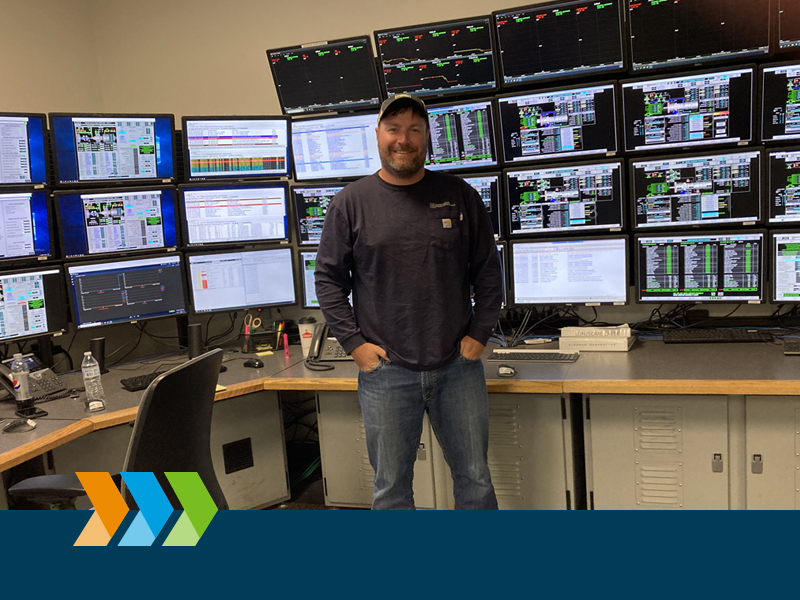- Products
- About us
- Responsibility
- Environment
- News
- Contact us
- Careers
-

At Deer Creek Station, the team is always working to determine the most cost-effective way to supply Basin Electric members with power.
Located in Brookings County, South Dakota, Deer Creek Station is a combined-cycle power plant that features two turbine-generator sets: one turbine fired by natural gas; the other is driven by steam. The plant’s natural gas, often purchased from Dakota Gasification Company, is delivered via the Northern Border Pipeline and a 14-mile underground pipeline to the plant.
But activities at the plant go beyond power generation. The plant is also the hub for dispatching power from most of the cooperative’s distributed generation fleet, an essential component to keeping reliable, affordable power flowing to the cooperative’s member systems.
“With remote operations, you get to operate most of the units on the distributed generation side. It’s a unique opportunity to learn about every unit in the fleet and be able to dispatch them so fast,” Dan Bather, operation technician at Deer Creek Station, says.
Deer Creek Station produces 297 megawatts of power but operates 1,100 megawatts through remote dispatching. The operations team works 24/7 and is able to schedule for day-ahead dispatch or can dispatch power on demand. In coordination with Basin Electric’s Marketing team, Western Area Power Administration (WAPA), and the cooperative’s other generation facilities, the team dispatches the safest and lowest-cost units.
“It’s two guys at a time who control a lot of that in the control room. It’s a lot of waiting, looking at
SPP (Southwest Power Pool) maps, verifying units are available and permissives are met, and monitoring the CEMS (Continuous Emissions Monitoring System) to make sure we’re in compliance with our air permits,” Bather says. “All of that can change in an instant to dispatching the whole fleet of gas turbines at once, under the right market conditions and generation demands. A big part of the job is watching and communicating when there is congestion or need for generation and completing an order based on prices and market demands.”
As the operators at Deer Creek Station are watching the controls for distributed generation, they are watching for many things.
“We’re checking alarms, emissions, and the balance of plant stuff, like gas pressures and temperatures,”
Bather says.
The decision of which units to run is not taken lightly. The team knows it’s important to make the most cost-effective decisions to best manage Basin Electric’s members’ capital.
“The most important thing on the remote operations side is communication. When it comes to making decisions, we work together with the remote sites and Marketing to make sure we’re available and able to generate in a safe way,” Bather says. ”If we have an issue, we just call that site and they troubleshoot or address it to make sure it’s available for generation.”
Bather says their busiest times are when temperatures are most extreme, and that wind also plays a factor.
“We do deal with wind, but don’t control much except resetting and monitoring the turbines,” he says. “But we do see an increased need for simple-cycle facilities, like Culbertson Generation Station, when there’s low wind. The peak hours in general seem to be a larger load.”
Besides coordinating the distributed generation side, Bather and the other operators also focus on keeping Deer Creek Station running efficiently.
“We cover both sides. We are truly the eyes and ears of Deer Creek. There’s a lead operator managing the controls and outside operators who do water chemistry, plant rounds, and safety-related stuff – all of the day-to-day routine stuff that’s important for keeping the plant running like it needs to,” Bather says.
“We’re much smaller than a lot of facilities, but we have the ability to produce here, and that’s a big advantage. We can meet demand and dispatch much quicker than baseload generation units, and fill in the gap where generation is needed.”
Bather says Deer Creek Station is a critical component for providing reliable and affordable energy for
Basin Electric and its members.
“Basically everything we do affects the membership. We look at it as a team, and at the end of the day, what’s good for the membership is good for us. We strive for availability and safety, and put that at the top of our priority list.”
Fall 2020 (Sept-Nov)
Winter 2021 (Dec-Feb)
Spring 2021 (Mar-May)
Summer 2021 (Jun-Aug)
Fall 2021 (Sept-Nov)
Winter 2022 (Dec-Feb)
Spring 2022 (Mar-May)
Summer 2022 (Jun-Aug)
Dakota Gasification Company
Headquarters:
1717 East Interstate Avenue | Bismarck, ND 58503-0564 USA
701.223.0441 | 1.800.242.2372
Great Plains Synfuels Plant
420 County Road 26
Beulah, ND 58523-9400 USA
701-873-2100
A subsidiary of:
Basin Electric wants all interested and qualified candidates to apply for employment opportunities. If you are an applicant with a disability who is unable to use our online tools to search and apply for jobs, or who needs other assistance or accommodations, please contact us at 701-223-0441. Please indicate the specifics of the assistance needed or provide your contact information, and a Basin Electric Human Resources representative will contact you. Basin Electric is an Equal Employment Opportunity Employer regarding race, color, religion, sex, sexual orientation, gender identity, national origin, disability, and veterans status.